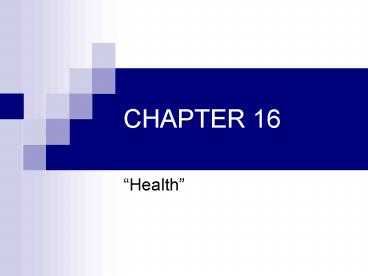Health - PowerPoint PPT Presentation
1 / 16
Title: Health
1
CHAPTER 16
- Health
2
Health
- Lifestyle your way of living (e.g., attitudes,
habits, choices, behaviors) - Bio-psycho-social health modelhealth is best
understood in terms of a combination of
biological, psychological, and social factors
3
Biological Factors That Influence Health
- Just a century ago, illnesses included infectious
diseases such as influenza, smallpox,
tuberculosis, typhoid fever, etc. - Major causes of death in the U.S. today heart
disease, cancer, and stroke (in that order) - Diabetes is also a major contributor to
disability and death.
4
Psychological Factors That Influence Health
- Causes of health problems include lack of self
control, emotional turmoil, and negative thinking
- Things to keep in mind regarding psychological
well-being and health - People can reduce the risk of coronary heart
problems by learning to control anger. - Chronic emotional stress is linked with
cardiovascular disease. - Positive emotion may be linked to the prevention
of colds. - Happy people are more likely than sad individuals
to engage in health-promoting behaviors.
5
Social Factors That Influence Health
- The frequency and intensity of health problems
varies across cultures. - Variations are linked to the following aspects of
cultures social, economic, technological, and
religious - Specific social factors that influence health
problems include SES, poverty, race, ethnicity
6
Eating Habits and Health
- Research studies have linked fat intake to
cancerthe more fat you eat, the more at risk you
become for cancer. - Two ways to possibly lengthen life through eating
habits caloric restriction and use of some
vitamin supplements (antioxidants-vitamins C, E,
and beta-carotene)
7
Obesity
- Obesity-30 overweight
- Obesity is measured by body mass index
(BMI)weight in relation to height according to
age. - More than 60 of U.S. adults are either
overweight or obese. - Obesity is linked to increased risk of
hypertension, diabetes, and cardiovascular
disease.
8
Possible Causes of Obesity
- Heredity
- Leptin
- Protein produced by the body anti-obesity
hormonethe more leptin you produce, the fuller
you feel - Set point
- the weight maintained when no effort is put into
gaining or losing weightthe more you eat, the
larger your set point becomes - Metabolism
- basal metabolism rate-BMRthe minimal amount of
energy an individual uses in a resting statethe
more your BMR declines, the easier it becomes to
gain weight - Environmental factors
- taste preferences, the availability of food,
energy-saving devices, declining physical
activity - Ethnicity and gender
- African American and Latino women become obese
faster than White women Latino men become obese
faster than African American and White men
9
Dieting
- Pros and cons of dieting
- Restrained eatersindividuals who chronically
restrict their food intake to control their
weight - Types of diet
- low-carb (Atkins)
- Exercise (benefits)
- Benefits of losing weight for overweight adults
10
Eating Disorders
- Anorexia nervosa
- Relentless pursuit of thinness through starvation
(weigh less than 85 of normal weight have an
intense fear of gaining weight have a distorted
body image) - More common in females
- Most are white, adolescent females
- Linked to high expectations and society beliefs
- Bulimia nervosa
- Bingeing and purging (at least 2 Xs a week for
three months) - Preoccupied with food strong fear of becoming
overweight depressed or anxious fall within
normal weight - More common in females, and more common than
anorexia also, more men experience bulimia when
compared to anorexia - Linked to increased dieting, pressure to be thin,
exaggerated emphasis on appearance, body
dissatisfaction, depression, low self-esteem, low
social support
11
Exercise
- Aerobic exercise
- Sustained exercise that stimulates heart and lung
activityjogging, swimming, cycling - Benefits of exercise
- Exercise helps prevent heart disease and other
chronic illnesses. - It improves self concept and reduces anxiety and
depression. - It can lead to a longer, healthier life.
- It can be used to effectively treat disability.
12
Psychoactive Drugs
- Substance that act on the nervous system to alter
states of consciousness, modify perceptions, and
change moods. - Depressants
- Slow down the central nervous system, body
functions, and behavior. - Alcohol, barbiturates, tranquilizers
- Stimulants
- Increase the activity of the nervous system.
- Caffeine, nicotine, amphetamines, cocaine
- Hallucinogens
- Modify perceptual experiences and produce
hallucinations. - LSD, marijuana, ecstasy
13
Addiction
- Psychological dependence
- Preoccupied with obtaining a drug for emotional
reasons - Physical dependence
- Discontinuing use of drug creates unpleasant,
significant changes in physical functioning and
behavior (withdrawal symptoms) - Models of addiction
- Disease model of addictionbiologically based
- Life-process model of addictionhabitual
response/source of gratification or security
14
Alcohol Use
- Alcohol is a depressant that slows down the
brains activities. - Drinking in college studentsbinge drinking
- Cultural differences
- Males drink more than females
- Some religions restrict it (Islam) others
consume it highly (Catholics, Reform Jews,
liberal Protestants) - Europeans (esp. the French) drink at high rates
- In Russia, use is also high in China, use is low
- Alcoholism
- The third leading killer in the U.S.
- Related to genetics (50-60) and environment
- Factors that predict recovery
15
Smoking
- Smoking is linked to
- Cancer
- Heart disease
- Chronic pulmonary disease
- Secondhand smoke
- Linked to cancer, and respiratory and middle-ear
diseases in children. - Nicotinea stimulant that increases energy and
alertness, and stimulates neurotransmitters that
have a calming or pain-reducing effect
16
Treatment Medical Services
- Factors that influence treatment seeking
- Life activity
- Belief systems
- SES and ethnicity
- Gender
- Good patient role (behaves properly) vs. bad
patient role (complains about everything--misbehav
es) - Reasons for failing to follow doctors orders
- Lack of satisfaction with quality of care
- Lack of trust in doctors































